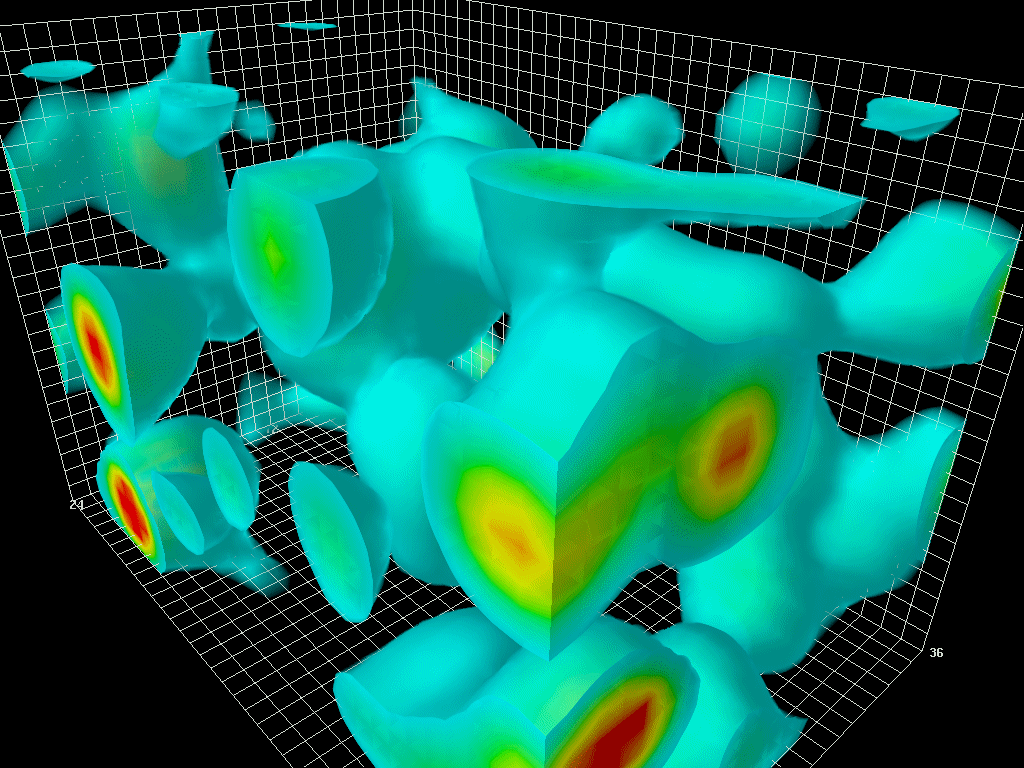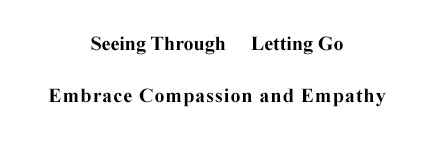In this post, we verify Buddhism’s non-luminosity by comparing it to a domain scientists deem an “empty space is not empty.” According to the host of the video, “Empty Space is NOT Empty” Veritasium, “empty space is not empty” is derived from the theory of Quantum ChromoDynamics, for which Dr. Frank Wilczek won a Nobel Prize in 2004.
Let’s first understand what “empty space is not empty” is.
In his video lecture, Quantum Fields: The Real Building Blocks of the Universe, Dr. David Tong, a professor of theoretical physics at Cambridge, clarified what “empty space is not empty” means in physics. He said, “Take a box, and take every single thing that exists out that box, take all the particles out the box, all the atoms out the box, what you are left with is a pure vacuum, and this is what the vacuum looks like.”
Then, he showed this computer simulation.

The original link can be seen here: http://www.physics.adelaide.edu.au/theory/staff/leinweber/VisualQCD/Nobel/ActionAPE5LQanimXs30.gif.
According to Veritasium, this short video “is a simulation by Prof. Derek Leinweber at the University of Adelaide” and “was made using a supercomputer to crunch the calculations of Quantum ChromoDynamics.“
Dr. Tong continued, “So, what you are looking at here is a computer simulation using our best theory of physics, which is called the Standard Model. It’s a computer simulation of absolutely nothing. This is an empty space, literally an empty space with nothing in it. This is the simplest thing you could possibly imagine in the universe. What you are looking at here is that even when the particles are taken out, the field still exists. ……..Even when there is nothing else there, the field is constantly bubbling and fluctuating in a very complicated way. These things are what we call quantum vacuum fluctuations. This is what nothingness looks like from the perspective of our current theories.“
Dr. Tong went on to describe what a quantum field is. A quantum field, he said, is a“fluid-like substances which are spread throughout the entire universe and ripple in a strange and interesting way.”
Now, let’s compare “empty space is not empty” with Buddha’s non-luminosity.
1) The Simplest Thing in the Universe
Let’s try first to summarize what Dr. Tong presented.
- “Empty space is not empty” because it is a domain full of quantum vacuum fluctuations.
- “Empty space is not empty” because quantum vacuum fluctuations stubbornly remained even when scientists attempted to remove everything to create a truly empty space.
- Therefore, scientists deem “empty space is not empty” the “simplest thing you could possibly imagine in the universe” because a space without fluctuations does not exist in the universe.
As discussed earlier, Buddha teaches that there are two realms of reality in the universe: the Ultimate Reality and non-luminosity. Both are eternal and have an adventitious relationship, “not causal” and “not an integral part” of each other.
While mentality does not fluctuate in the Ultimate Reality, it fluctuates incessantly in non-luminosity. Their fluctuating statuses are why they are “not an integral part” of each other.
Therefore, like “empty space is not empty,” non-luminosity is also the “simplest thing you could possibly imagine in the universe” in Buddhism, except that there are two realms of reality in Buddha’s universe, separated by their different fluctuating statuses.
2) Speed of Annihilation
In the video, “Empty space is not Empty,” Veritasium provides a more technical description of the quantum field fluctuations by calling them “quark-and-gluon field fluctuations that come and go incredibly quickly. The frame rate of this simulation is one million billion billion frames per second.” In other words, one with twenty-four zeros behind it per second!
Furthermore, Veritasium added, “The dimensions of this box are absolutely tiny. They are millions of a billionth of a meter, roughly enough space to stick two protons. But there are no protons here. This is a simulation of the vacuum on its own, what we normally think of as ’empty space.'” Dr. Derek Lineweber, a quantum scientist, added further details as he described these fluctuations as quarks being annihilated.
Now, let’s hear from a cosmologist, Dr. Lawrence Krauss, about his descriptions of the same phenomenon. In his video lecture, “A Universe From Nothing,” Dr. Krauss, deeming “empty space is not empty” as “nothing is not nothing,” and epiphenomena virtual particles, said, “if you take empty space, and that means get rid of all the particles, all the radiation, absolutely everything so there is nothing there. If nothing weighs something, then it contributes to a term like this (Einstein’s Cosmological Constant). That sounds ridiculous. Why should nothing weigh something? Nothing is nothing. The answer is that nothing isn’t nothing anymore in physics. Because of the laws of quantum mechanics and special relativity, on extremely small scales, nothing is really a boiling bubbling brew of virtual particles that pop in and out of existence in a time scale so short that you can’t see them.”
However, “weighing something” is important in separating science and Buddhism. As “a quantitative property,” energy represents numbers in equations and cannot have weight. On the other hand, although mentality is invisible, it is an obviously present entity that can “weigh something,” especially since it is spread throughout the universe, as Buddha teaches.
Now, let’s hear from Buddha and how he described the same phenomenon in Śūraṅgama Sūtra.
In Mahayana Śūraṅgama Sūtra (Chinese=大佛頂首楞嚴經) lectured Ananda, “a primary attendant of the Buddha and one of his ten principle disciples,” “Ananda, you still have not understood that all dust floating and sinking are illusional manifestations, born here, also annihilated here. (They are just) illusional manifestations, their true self-nature remains their ontological essence, enlightened and luminous. (Chinese=阿難!汝猶未明一切浮塵諸幻化相,當處出生,隨處滅盡;幻妄稱相,其性真為妙覺明體).”
The point of Buddha’s lecture to Ananda is to correct Ananda’s misunderstanding of reality, as he considers dust reality rather than mentality, its underlying nature. He wants to tell Ananda that “all dust floating and sinking are delusional manifestations” because “their true nature remains their ontological essence, enlightened and luminous.”
Now. let’s compare Buddha’s statement to those of Dr. Tong and Dr. Krauss.
- By comparing Dr. Tong’s description of the quantum field as “spread throughout the entire universe and ripple in a strange and interesting way” and Dr. Krause’s description that the virtual particles “pop in and out existence” in a “boiling brew,” we can presume that what they describe are fluctuations, as is Buddha’s use of “floating and sinking” in his lecture to Ananda.
- From the description that “all dust floating and sinking are illusional manifestations” because “their true nature remains their ontological essence, enlightened and luminous,” we can surmise that the dust floating and sinking are “neighbor-to-Emptiness dust” because the descriptions “ontological essence” and “enlightened, and luminous” are depictions of Emptiness, the realm of the enlightened Ultimate Reality.
- As discussed in the last post, “neighbor-to-Emptiness dust” is the Buddhist equivalent of an epiphenomenon, which can also be considered a virtual particle.
- The realm of non-luminosity and “neighbor-to-Emptiness dust” are the ideal surroundings for Buddha to lecture Ananda on his delusional misunderstanding of reality. As ripples in non-luminosity, the “neighbor-to-emptiness dust,” is the first incident when mentality fluctuates and takes the form of a ripple. It is the most fundamental place to tell Ananda that form and mentality are fundamentally one and that while ripples look like phenomenal reality, their essence is mentality.
Therefore, we can be confident that all three descriptions, Buddha’s dust that is “born here, also annihilated here,” Veritasium’s quarks being annihilated at “one million billion billion frames per second,” and Dr. Krauss’ “virtual particles” “pop in and out existence in a time scale so short that you can’t see them,” all refer to the same phenomenon, “the simplest thing in the universe,” what scientists call “empty space is not empty,” and “non-luminosity” in Buddhism,
3) One field everywhere for all time.
In this episode of the “How is the Cosmos Constructed” series, Dr. Wilczek shared additional insight into the scientific view of how the Cosmo is constructed with the host of Closer to Truth, Dr. Robert L. Kuhn.
Dr. Wilczek said the current quantum mechanical knowledge confirms that “the most basic objects out of which to construct the universe are not particles.” Instead, he clarified, they are “objects we call quantum fields. We think of them as space-filling ethers that create and destroy the objects, the particles.”
However, in addition to agreeing with Dr. Tong that quantum fields are the building blocks of the universe, Dr. Wilczek added that “there is something called the electronic field that’s what actually appears in our equations that creates electrons. Since there is only one such field, and it has the same properties everywhere and for all time, all the electrons it makes have the same property.”
Now, suppose we replace Dr. Wilczek’s electronic field with Buddha’s non-luminosity, equations with meditation, and electrons with “neighbor-to-Emptiness dust,” we get what Buddha’s teaching on how the universe is created, “there is something called non-luminosity that’s what actually appears meditatively that creates “neighbor-to-Emptiness dust.” Since there is only one such field of non-luminosity, and it has the same properties everywhere and for all time, all the “neighbor-to-Emptiness dust” it makes have the same property.”
Indeed, non-luminosity, being eternal and spread throughout the universe since immemorial, is also the “one field everywhere for all time” in Buddhism and provides all the functions that quantum mechanics deems necessary to build Buddha’s universe. The main difference is that electrons do not make consciousness, while “neighbor-to-Emptiness dust” does.
4) Building Blocks of the Universe
Buddhism shares with quantum mechanics the idea that a fluctuating field is the building block of the universe, albeit with different construction materials. This was discussed earlier, so it will not be repeated here.
5) Epiphenomenon
The last post discussed that the “neighbor-to-Emptiness dust” is the equivalent of quantum mechanics’ epiphenomenon. So, again, it will not be discussed here.


